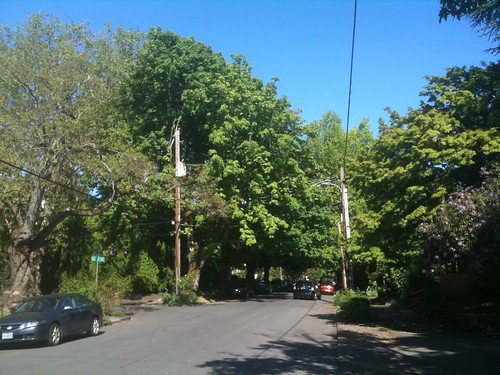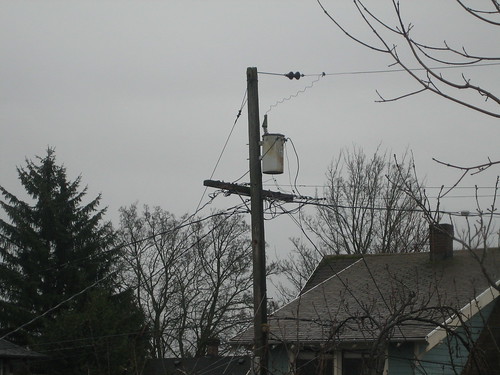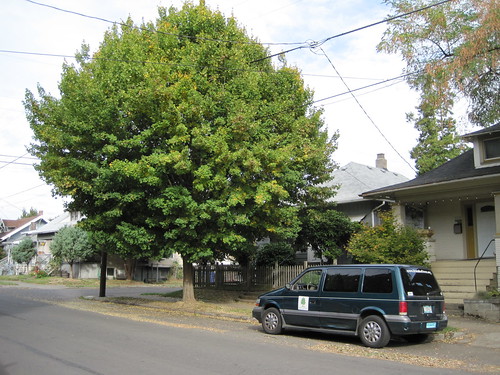Tag: Power Lines
Trees and power lines: Should we plant tall trees under primary power lines?
By Brighton West
So in my last two posts, I talked about planting the “Right Tree in the Right Place.” This suggests we should plant small trees under lines where the utility prunes the trees away from the power lines and tall trees under lines that don’t get clearance pruning. But this means that we are planting a lot of small trees.
In older neighborhoods with big trees that have had clearance pruning, if a tree dies, it’s replaced with a much smaller tree that won’t grow into the lines. But we also know that larger trees provide more stormwater management, more carbon sequestration, more energy benefits to the adjacent property and higher property values. Big trees also do a better job of hiding the power lines. So avoiding the need for pruning costs a lot in terms of the other benefits.
Well, during the initial prunings, I’ll admit that they look kind of ugly. But with proper pruning, within about 10 years, the tree will start to grow around the power lines completely hiding the lines, and even shading out future limbs from growing into the lines. I’ve seen streets in Sellwood and Irvington where the power lines are so well hidden in mature northern red oaks, big leaf maples and horse chestnuts that you can’t tell they are there – and the street is beautiful because of this.

So the questions is: What do you think? Should we plant big trees under power lines, live through the “ugly pruning” phase and end up with all the benefits of large trees in 20-30 years? Or should we continue the current approach of planting small tree under primary power lines?
West is the programs director at Friends of Trees: [email protected]; 503-282-8846 ext. 19
Trees and power lines: When is it OK to plant a tall tree under power lines?

By Brighton West
In my last post, I pointed out that the rule ‘The Right Tree in the Right Place’ tells us to plant small trees under primary lines. But not all overhead wires are primary power lines. Those “telephone poles” hold primary and secondary power lines, cable lines, telephone lines, and other lines.
Trees growing into primary power lines present a serious safety hazard, so the power company clears trees around these lines. But the other lines can run right through the center of a tree without causing problems. Sometimes the line owner will install some additional protection on the line if it’s rubbing against the trunk, but they usually don’t prune the tree for clearance.
Friends of Trees and most urban foresters believe that planting the largest tree that fits the planting space is the right thing to do—more stormwater captured, more carbon sequestered, more energy benefits to the adjacent property, and higher property values, among other reasons. So if the “telephone poles” don’t have primary power lines and the planting strip is wide enough for a tall tree, then the city policy calls for a tall tree.
That’s one great reason to get a free urban forestry inspection to plant a tree. (It’s also required by the city.) The inspectors are trained to identify primary power lines and the other more rare situations that can restrict tree growth, such as uninsulated secondary power lines.
But I know you are curious to see what the difference is. The photo at the top of this page is the “telephone pole” outside my bedroom window.

To the right of the pole, we have primary power lines. They are at the top above the transformer. Below are secondary power lines. So at this location, the houses to the right would need to plant small trees, and those to the left would plant tall trees.
Here is an example of a tree growing through secondary power lines. Imagine if this entire street had large street trees. The ugly power lines would be completely hidden.
Coming next Monday: Trees and Powerlines: Should we plant tall trees under primary power lines?
West is the programs director at Friends of Trees: [email protected]; 503-282-8846 ext. 19
Trees and power lines: A bad idea?

By Brighton West
Someone recently asked why Friends of Trees planted trees under power lines, implying that it was a bad idea. Not so if you follow the rule “Right Tree in the Right Place.”
Trees have different types of growing habits. We know that Doug-Firs have a strong central leader (the main trunk goes straight up), Accolade Elms don’t (their branches all spread out and create a vase shape), and Prairiefire Crabapples only grow about 20 feet tall.
Knowing these characteristics, we can select a tree that doesn’t grow tall enough to interfere with primary power lines—and thus won’t need to be pruned by the power company.
I don’t know of many people who like to look at overhead wires, so selecting a low-growing tree to grow underneath the primary lines can be a good way to screen these lines from eye level. And if the lines aren’t primary power lines, a tall-growing tree could be the most effective—but more about that in my next blog post.
Coming next Monday: Trees and Powerlines: When is it OK to plant a tall tree under power lines?
West is the programs director at Friends of Trees: [email protected]; 503-282-8846 ext. 19
